Peace Out, Plastic. These New Climbing Holds Are Made of Mushrooms.

In a bathroom in Berlin, two women are growing mushrooms that could become the jugs and crimps of your next gym project. Together, Marta Agueda and Manuela Garcia are leading MAD, the world’s first mycelium-based climbing holds company.
But mushrooms, as it turns out, aren’t the only alternative materials with which hold-makers are experimenting. While I originally planned to write a story exclusively about the shroom holds of Germany, my research turned into a surprisingly uplifting rabbit hole. At a time when concerns over plastic are reaching a fever pitch—and as new data emerges about the toxicity of chalk and climbing shoe rubber inhaled indoors—this is a hopeful account about holds that are better for the planet. But first, just how bad are today’s climbing holds when it comes to the environment?
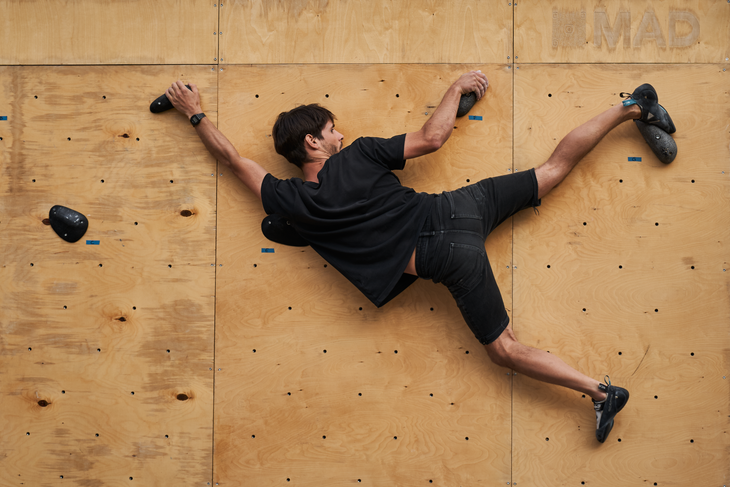
Climbing on plastic? Not fantastic.
When you’re “pulling on plastic,” you’re grasping at polyurethane (PU) or polyester (PE). Manufacturers pour liquid PU and PE into molds. Usually, this pourable plastic does not come from a recyclable material. Nor are plastic holds typically designed to be recycled after they reach the end of their lifespan.
As a result, an estimated 7.7 million holds are produced each year, according to a global market study referenced by Ghold, a French climbing holds manufacturer. Most of these holds are designed to be used for just a few years before they need to be refurbished, donated, or landfilled. The study also found that on average, only 10% of end-of-lifespan holds are sent for repair or refurbishing by gyms. “Since these holds are not recyclable, they will all eventually become waste,” says Sébastien Leprivey, a Ghold founder. With the growth of the industry, the volume of plastic waste will only become more pronounced over time.
For a bigger-picture view of the carbon footprint of indoor climbing, we can look at the lifecycle assessment of “Titan,” a bouldering wall used in the 2024 Summer Olympics. The International Federation of Sport Climbing (IFSC) and International Olympic Committee (IOC) commissioned the assessment. This particular wall included about 20 wooden holds and 250 plastic ones.
The assessment found that Titan’s carbon footprint equated to 94 flights from Paris to New York, or 2,654 smartphones. While this assessment also covered elements like the panels behind the holds and the mats below, it does underscore the carbon toll that comes with indoor climbing. While the mats proved to be the greatest carbon culprit, the plastic holds created the second largest environmental impact.
Conventional plastic holds don’t exactly last long either. According to French company Ghold, the average lifespan of a PU hold is just one to two years, while a PE hold lasts on average between three and five years. The Titan lifecycle assessment calculated the average estimated lifespan of the holds (a mix of PE and PU) to be two years. According to Garnet Moore, executive director of the Climbing Wall Association, the average small to medium-sized gym has a minimum of 6,000 to 10,000 holds. With over 870 gyms in North America alone (according to the Climbing Business Journal), that’s at least five million holds in play that will only last between one year and five years.
Go behind the scenes into the origins and evolution of this story on sustainable climbing holds
But it doesn’t have to be this way. Methods exist to reduce the impact of the common climbing hold. Hollow-backed holds, for example, can significantly cut down on plastic usage. Manufacturers can also integrate plastic with other materials to reduce the amount of fossil fuel-based material required. And holds can be refurbished and refinished to extend their lifespan through companies like the UK’s Contact Holds or NRHolds in France.
But across Europe, a number of forward-thinking companies are innovating to make holds from recycled plastic—or alternative materials to avoid plastic altogether.

Climbing holds made from alternative materials
What does a non-plastic hold look like? Over in Denmark, a company called Nature Climbing is pioneering a return to rock—yes, even indoors. With oversight from the European Forest Stewardship Council, they’ve been hand-crafting climbing holds out of Scandinavian granite and oak for about a decade.
But some hold manufacturers are getting even more creative with cost-effective, all-natural answers to the synthetic setting of the gym.

Back to the mushrooms
It all started when Marta Agueda, a boulderer and sport climber from Spain, met Manuela Garcia while climbing in a gym three years ago. Garcia had moved to Berlin from Argentina and loved bouldering. Since they found themselves far from any crags in the city, they spent most of their time climbing indoors. Across the 10 and counting climbing gyms in Berlin, they realized “just how much material goes into building those spaces—and how much of it is plastic,” according to Garcia. They resolved to do something about it.
Architects and product designers by trade, Agueda and Garcia heard through a friend about fungi-based construction materials. So they decided to apply the science to climbing holds. Fast forward a few years, and they found themselves growing fungi in Garcia’s bathroom, and DIYing their own bioreactor.
While it may all sound somewhat fledgling, MAD has been testing its holds on routes for over a year. With proper investment, they estimate their mushroom-based holds could enter the market in just a year or two.
If you’re wondering how the spongy texture of a mushroom would lend itself to a durable hold, it’s because they’re not using the part of a mushroom that most people think of first. Agueda and Garcia are focused on the mycelium—the subterranean, root-like structure of a mushroom, which is actually the whole organism.
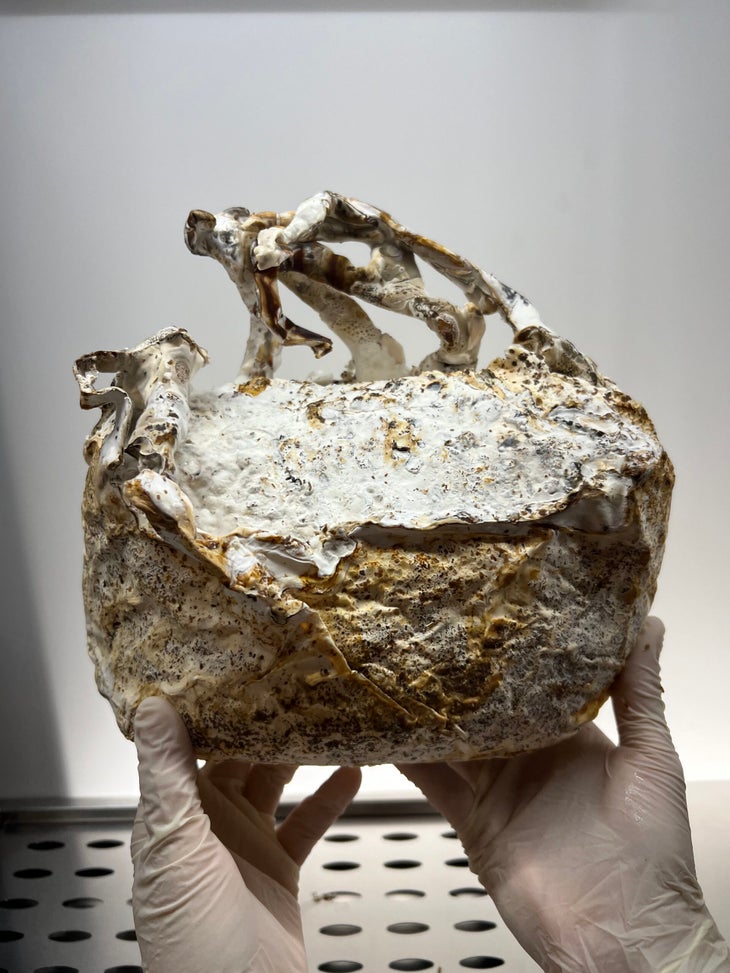
So far, prototype testing has gone well. Routesetters and climbers have tested holds at two climbing gyms in Berlin. Yet several challenges remain. One is ensuring the bolt holes are structurally sound. Bigger picture, Agueda and Garcia are working on making their production process more efficient and scalable through, for example, vertical mushroom farming techniques. “Our goal is to be price-competitive with plastic holds so climbers and gyms can make decisions based on sustainability, not just cost,” Garcia explains.
But perhaps the greatest barrier MAD faces is the variability of working with a living organism. “The biggest challenge is the nature of the material itself,” Garcia says. “It’s living. It behaves differently than traditional materials.” Recently, they partnered up with a major research institute in Germany to collaborate with a mycologist who can help them better harness mycelium.

Down the line, the women of MAD hope to apply their mycelium prowess to more climbing products and expand into other industries. “Mycelium has so much potential beyond holds,” Agueda explains. “It could be applied to things like helmets, padding, maybe even parts of climbing shoes. We’re just getting started.”
So are MAD’s holds edible? (I had to ask). “Not yet,” Garcia laughed. “But honestly, we love the idea of a climbing wall you could eat.”
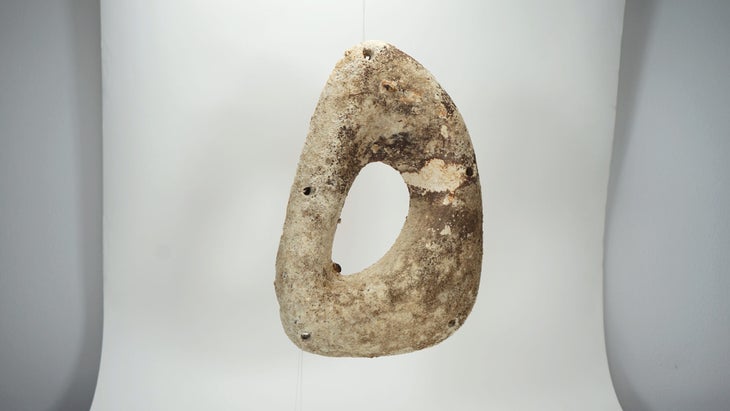
Sandstone from scratch
“I’m really radical,” says Andreas Trunz, the innovator behind RSTTR holds in northern Switzerland, of his commitment to sustainability. He also has a passion for problem solving. In his quest to produce a totally non-toxic hold, he has spiraled into a research journey on materials, from the main ingredients, to the hardeners, to the dyes.
It all started a couple years ago, when he was having a beer with his friend, a composite engineer. They started talking about the glaring gap between the current hold market, and a recent paper from the Swiss Gym Association requesting more sustainable hold options. As an alpinist who says he loves all climbing disciplines, Trunz wanted to do something about it.
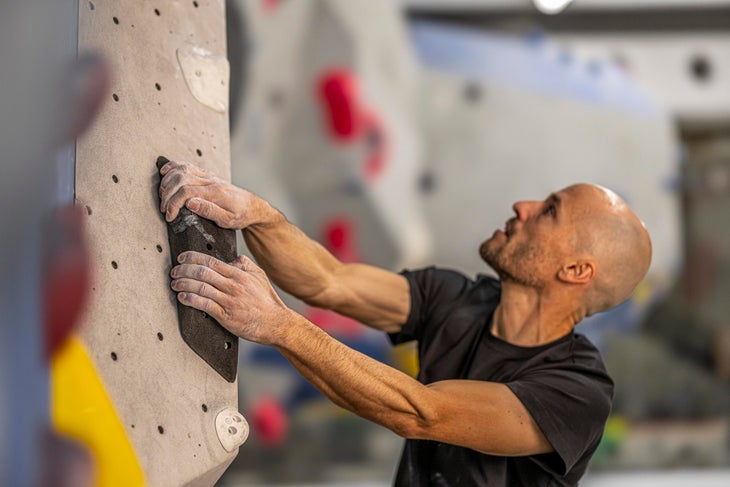
His vision for a less-plastic indoor climbing future? One word: Bioresins. Primarily, Trunz has been using vegetable oils sourced from North America to develop a material he describes as “a renewable, castable sandstone—based on a 100% plant-based, non-persistent, non-toxic resin.” The specific ingredient remains under wraps; it’s a trade secret.
The crux of these bio-based holds? The hardener that allows the hold to set in its mold. Trunz explains that others have tried manufacturing holds using partially bio-based formulations, but they still relied on fossil fuel-based hardeners.
“We are only interested in looking at solutions that are 100% safe,” he explains. So he started searching for ingredients that he’d let his own kids mix together without concern. “It’s so safe, I’d eat it,” Trunz says. “Well—not the quartz, for the sake of my teeth.” After striking out with a number of hardener solutions, he found that mixing bioresins with mineral fillers like sand worked. Not only did it behave like sandstone, but it also felt like sandstone, too.
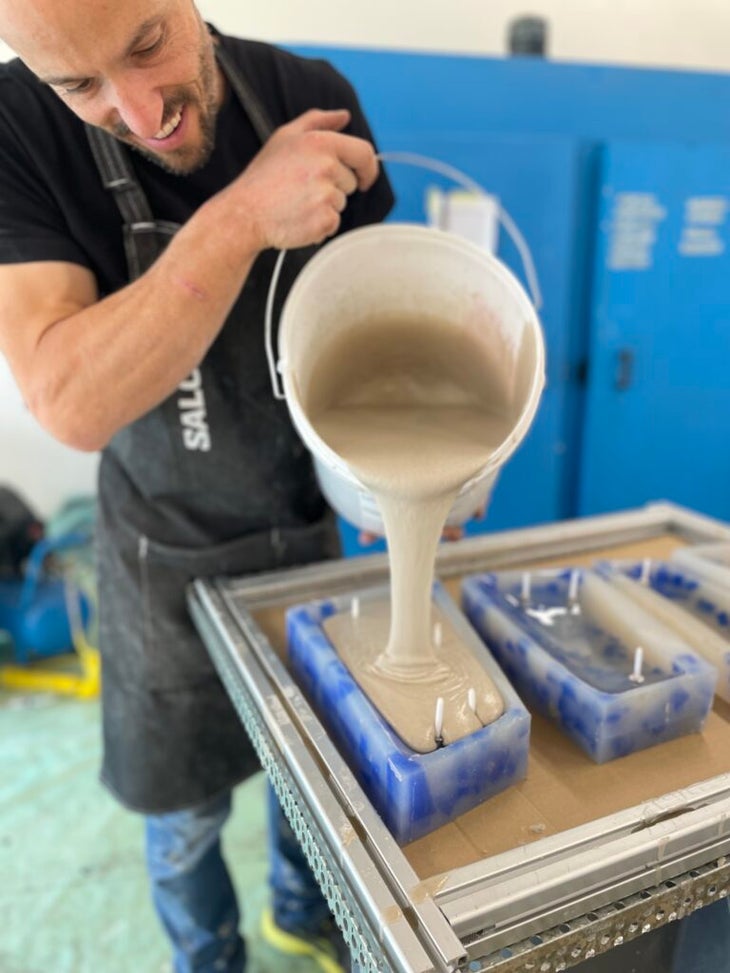

Dyes represent the last piece of the puzzle. Trunz wants to keeping the colors natural. To meet that commitment, he’s working with plant-based and iron oxide-based dyes that produce black, white, green, brown, and more earth tones.
So how does this completely natural climbing hold stack up in testing? Radically well. RSTTR tested its holds for over 11 months at a gym in Switzerland, and has since introduced its holds at six more gyms across the country, as well as in one local competition in Zurich. Testing shows that these bio-based holds offer far better shock resistance than polyester-based holds and much improved grip. “Even a huge amount of wear and abrasion on a small foothold won’t polish it,” Trunz explains. “The texture refreshes itself.”
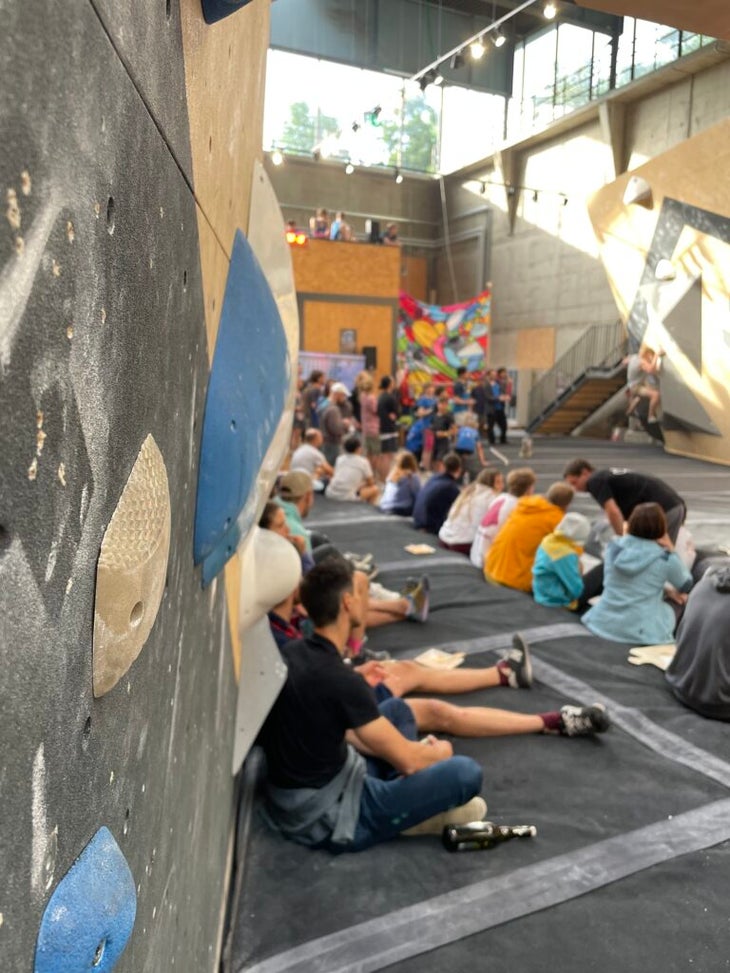
Bioresin holds also significantly exceed the lifespan of PU holds, though the upfront cost is slightly higher. However, the company remains optimistic that it can reduce cost as it scales. And when it comes to carbon footprint, an initial lifecycle analysis shows significantly lower emissions associated with RSTTR holds compared to conventional holds. However, Trunz says he needs to do more in-depth research before citing specific numbers.
Currently, RSTTR hopes to enter the U.S. market by 2028 at the latest—i.e., in time for the Summer Olympics—ideally using a U.S.-based production.
Planet-conscious plastic holds
As MAD and RSTTR innovate with alternative materials, other hold manufacturers are pioneering better ways of harnessing plastic. Namely, they use recycled plastics to make holds, or create plastic holds that can be recycled again and again to reduce the overall carbon footprint.
In the Netherlands, Greenholds is shaping holds from plastic designed to last three to four times longer than the standard PU hold. The wear-resistant nylon they use is four times stiffer and eight times as strong as a conventional plastic holds, according to the company’s lab tests. You can also recycle each hold six times without any loss in performance. A 1% for the Planet member, Greenholds further reduces its impact by utilizing post-industrial waste; it sources polyamide primarily from the auto industry.
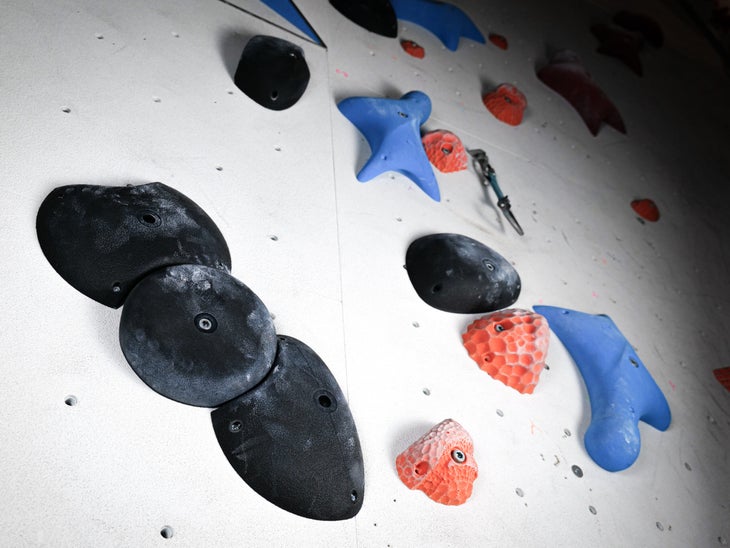
Greenholds’ smarter approach to plastic is already commercially available around Europe, but they haven’t yet found a distributor in the United States. The primary obstacles at this point remain a price-restricted market. “The dialogue regarding a circular economy is getting started,” says Tim Mullens, co-founder of Greenholds. “But gyms are struggling, so unfortunately price prevails over quality and the planet.” He explains that due to their extended lifespan, Greenholds do actually beat conventional holds on price point. However, right now, gyms and hold distributors focus too much on short-term bottom lines to invest.
Meanwhile, in the French Alps, Ghold (pronounced “gold,” a nod to the precious metal that can be melted and recast indefinitely) wants to become the “Gore-Tex of climbing holds.” Basically, they hope to master the technology for other brands to harness. By melting thermoplastic polyurethane at a much higher temperature, a Ghold hold can be recycled up to 10 times before reaching the end of their lifespan. The three Frenchmen behind the operation have been testing their material for four years to ensure it’s durable enough to meet the needs of climbers. After tinkering with the formula, Sébastien Leprivey, a Ghold co-founder, told me that they now have the most durable PU holds on the market.

Durability aside, the recyclability potential of Ghold is staggering. Leprivey estimates that each hold lasts two or three years, depending on usage. After that initial period, each hold can be fully recycled more than 10 times. That means that a Ghold’s lifespan equates to 20 to 30 years—19-28 more years than a conventional PU hold. So while Ghold uses around 30% recycled materials in its original product (with the remaining 70% being virgin material), its sustainable virtues lie in its recyclability and lifespan. That said, as it scales, it will be able to produce holds from 100% recycled thermoplastic PU.
Like Greenholds, Ghold is currently focused on scaling. As an eight-person operation that’s been in development for five years, the company initially focused on developing its technology. Now, it’s entering a fundraising phase to be able to meaningfully enter the market. For example, they need a new machine to be able to produce bigger macro holds, as well as other resources to scale.
But the progress Ghold has made is promising. Leprivey says they’ve partnered on commercializing their holds with some of the largest hold brands out there. So far, they’ve worked with Artline, EP Climbing, and Climbing Business Journal 2024 Shaper of the Year Decoy. Climbers have even pulled on Ghold holds at several competitions, including the 2024 Salt Lake City World Cup.
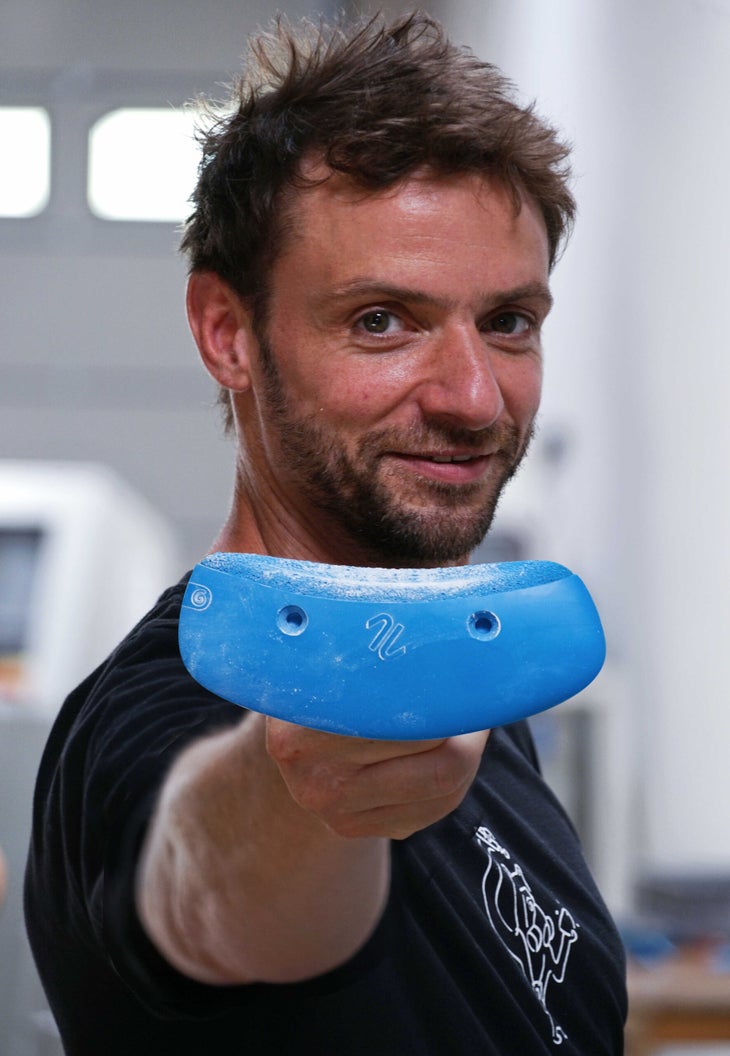
The future of climbing holds
A common thread exists among all the creative hold-makers trying to do better by the planet. All of them, as you’d expect, are climbers. But most of them found themselves in urban areas, not able to climb outside as much as they’d like. In a world of plastic, they became increasingly aware of the environmental impact of indoor climbing—and decided to do something about it. Leprivey saw the snow around his ski resorts melting unseasonably early. Trunz of RSTTR wanted a product that’s as non-toxic as possible for his kids and all humans. MAD’s Agueda and Garcia wanted to do something about the staggering levels of plastic in their sport. And Mullens of Greenholds believes that “sustainability and respect for nature are intertwined with our climbing sport.”
Of course, another common thread is that all of these innovative hold-manufacturers are tinkering away in the labs of Europe. Many of them have also faced challenges in entering the U.S. market. I’m sure there are U.S. innovators that I’ve overlooked. But I do hope that this story spreads awareness about the radically sustainable ideas shaping the climbing holds of tomorrow across the pond.
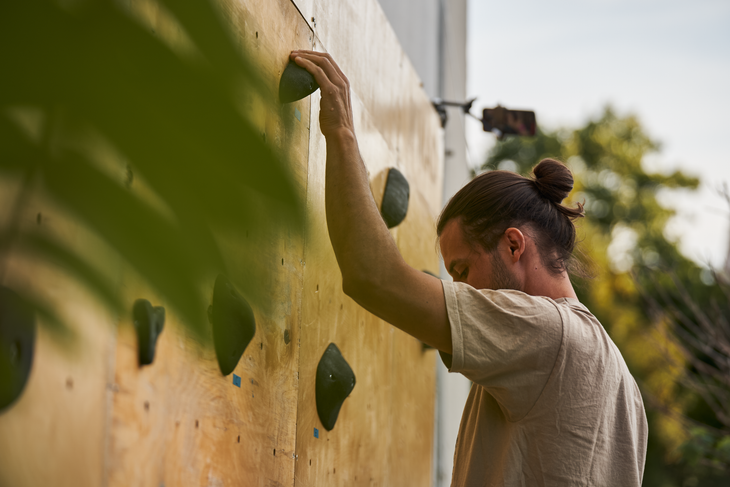
Ultimately, Mullens says that in a couple years, we could see a shift in the climbing holds market. But he doesn’t see that happening without policies designed to trigger that shift. “Laws and regulations will be necessary to push the transition towards sustainability,” Mullens predicts.
Thomas Ferrandi, Director of Marketing with Artline holds, says, “It’s a change in the way of working and thinking about indoor climbing.” Hold manufacturers, hold brands, climbing competition organizations, gym owners, and gym climbers all have a role to play in embodying that change. And maybe one day, we can pull on recyclable plastic—or fungi or bioresins—in good environmental conscience.
Correction (August 13): An earlier version of this story stated that an estimated seven million holds end up in the landfill each year. This statistic was derived from a global market study that found that 7.7 million holds were produced each year. The sources in this story deduced that since those holds would eventually be landfilled within several years, on average the same number of holds would end up in a landfill annually. However, without concrete data regarding the number of holds that actually end up in the landfill annually, we have amended this section accordingly.